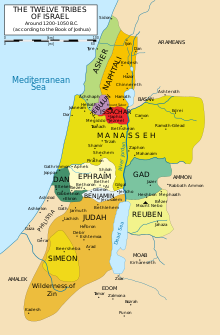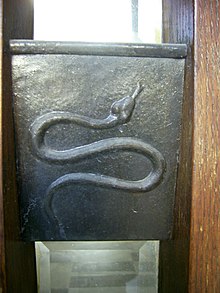Tribe of Dan
| Tribes of Israel |
|---|
 |
The Tribe of Dan (Template:Lang-he-n), meaning, "Judge," was one of the tribes of Israel, according to the Torah. They were allocated a coastal portion of land when the people of Israel entered the Promised Land, later moving northwards.
Origin
According to the Torah, the tribe consisted of the descendants of Dan, a son of Jacob and Bilhah, Rachel's maidservant (Genesis 30:4). In the biblical account, Dan is one of the two children of Bilhah, the handmaid of Jacob's wife Rachel, the other child of Bilhah being Naphtali. Scholars see this as indicating that the authors saw Dan and Naphtali as being not of entirely Israelite origin (being descendants of handmaids rather than of full wives).[1] Some have noted that the territory of the handmaid tribes happens to be the territory closest to the north and eastern borders of Canaan, thus exposing them to Assyria and Aram.[2] However, other tribes born to wives, including the firstborn Reuben, were also included on the eastern outskirts, and immediately adjacent to Israel's more traditional enemies at the time of their entry to Canaan, the Moabites and Ammonites.

History

In the Biblical census of the Book of Numbers, the tribe of Dan is portrayed as the second largest Israelite tribe (after Judah).[3] Some textual scholars regard the census as being from the Priestly Source, dating it to around the 7th century BC, and more likely to reflect the biases of its authors.[4][5] In the Blessing of Moses, which some textual scholars regard as dating from only slightly earlier than the deuteronomist,[4] In Moses' blessing Dan is prophesied to "leap from Bashan"; scholars are uncertain why this should be since the tribe did not live in the Bashan plain, east of the Jordan.[1]
Conquest and territory
According to the biblical narrative, following the completion of the conquest of Canaan by the Israelite tribes after about 1200 BCE,[6] Joshua allocated the land among the twelve tribes. Dan was the last tribe to receive its territorial inheritance.[7][8] The land originally allocated to Dan was a small enclave in the central coastal area of Canaan, between Judah, Benjamin, Ephraim and the Philistines.[9] On the north the territory of Dan ended opposite Joppa, the modern Jaffa. This territory, not very extensive originally, was soon diminished by its dangerous neighbors, the Philistines.[1] The tribe was only able to camp in the hill country overlooking the Sorek Valley, the camp location becoming known as Mahaneh Dan ("Camps of Dan"). (Joshua 19) The region they were trying to settle extended south into the Shephelah in the area of Timnah; as a result, the modern state of Israel refers to the region as Gush Dan (the Dan area).
From after the conquest of the land by Joshua until the formation of the first united Kingdom of Israel in c. 1050 BC, the Tribe of Dan was a part of a loose confederation of Israelite tribes. No central government existed, and in times of crisis the people were led by ad hoc leaders known as Judges.[10]
The most celebrated Danite was Samson, a Danaite judge from the period of settlement in the lands allotted by Joshua. Pnina Galpaz-Feller sees similarities between the story of Samson and Denyen tribal legends.[10]
As a consequence of the pressure from the Philistines, the tribe abandoned hopes of settling near the central coast, instead migrating to the north of Philistine territory, and after conquering Laish, refounded it as their capital (renaming it Dan) (Judges 18). Thus their territory in the end lay northeast of that of Naphtali, east of the upper Jordan River, near its eastern sources, and defining the northern extent of the land of the Israelites. A number of biblical texts thus refer to "All Israel, from Dan to Beersheba".
United Monarchy
With the growth of the threat from Philistine incursions, the Israelite tribes decided to form a strong centralised monarchy to meet the challenge, and the Tribe of Dan joined the new kingdom with Saul as the first king. After the death of Saul, all the tribes other than Judah remained loyal to the House of Saul, but after the death of Ish-bosheth, Saul's son and successor to the throne of Israel, the Tribe of Dan joined the other northern Israelite tribes in making David, who was then the king of Judah, king of a re-united Kingdom of Israel.[11]
Northern Kingdom of Israel
However, on the accession of Rehoboam, David's grandson, in c. 930 BC the northern tribes split from the House of David to re-form a Kingdom of Israel as the Northern Kingdom.[11]
Assyrian conquest and demise
As part of the Kingdom of Israel, the territory of Dan was conquered by the Assyrians, and exiled; the manner of their exile led to their further history being lost.
Claims of descent from Dan
Simon Magus, also known as Simon the Sorcerer, and Simon the Magican, came from the village of Gitta (also spelled Getta) in Samaria, according to Justin Martyr;[12] a site settled by the tribe of Dan according to Josephus.[13][14] Justin, who was himself a 2nd-century native of Samaria, wrote that nearly all the Samaritans in his time were adherents of Simon. Surviving orthodox texts, such as those of Irenaeus, Justin Martyr, Hippolytus, and Epiphanius, regarded Simon as the source of all heresies, including Gnosticism. Ethiopian Jews, also known as Beta Israel, claim descent from the Tribe of Dan, whose members migrated south along with members of the tribes of Gad, Asher, and Naphtali, into the Kingdom of Kush, now Ethiopia and Sudan,[15] during the destruction of the First Temple. This position is supported by former Sephardic Chief Rabbi Ovadia Yosef.[16] They are said to have fought with the natives.[17] Charles Upton relates the serpent voodoo God Danbhala as derived in part from a heterodox form of Ethiopian Judaism.[18]
Characteristics
Their primary trade characteristic was seafaring, unusual for the Israelite tribes.[19] In the Song of Deborah the tribe is said to have stayed on their ships with their belongings.[20][21][22]
Iconography

Modern artists use the "scales of justice" to represent the Tribe of Dan due to Genesis 49:16 referencing Dan "shall achieve justice for his kindred". However, more traditional artists use a snake to represent Dan, based on Genesis 49:17, "Let Dan be a serpent by the roadside, a horned viper by the path, That bites the horse's heel, so that the rider tumbles backward."
Book of Revelation
The Book of Revelation (7:4–8), mentions that people from the twelve tribes of Israel will be sealed. The selection of the twelve tribes does not include the names of Ephraim and Dan, although their names were used for the twelve tribes that settled in the Promised Land. It has been suggested that this could be because of their pagan practices.[23] This made Hippolytus of Rome and a few Millennialists propose that the Antichrist will come from the tribe of Dan.[24][25]
See also
References
- ^ a b c "Dan", Jewish Encyclopedia
- ^ Peake's Commentary on the Bible
- ^ Numbers 1:39
- ^ a b Richard Elliott Friedman, Who Wrote the Bible? (Harper San Francisco) (1987) ISBN 0-06-063035-3
- ^ "Numbers, Book of", Jewish Encyclopedia
- ^ Kitchen, Kenneth A. (2003), "On the Reliability of the Old Testament" (Grand Rapids, Michigan. William B. Eerdmans Publishing Company)(ISBN 0-8028-4960-1)
- ^ Petrie, George Laurens. "Jacob's sons", Neale, 1910. p. 111
- ^ Butler, James Glentworth. "The Bible-work, the Old Testament: Joshua, Judges, Ruth, 1st and 2nd Samuel, 1 Chronicles XI., 1 Kings I-XI., 2 Chronicles I-IX", Funk & Wagnalls, 1889. p. 129
- ^ NAB, Joshua 19, n.5
- ^ a b Galpaz-Feller, Pnina. Samson: the hero and the man, Peter Lang, 2006. ISBN 3-03910-852-2, ISBN 978-3-03910-852-7. p. 278-282
- ^ a b Ring, Trudy; Salkin, Robert M. and La Boda, Sharon. International Dictionary of Historic Places, p.215, Taylor & Francis, 1996 ISBN 9781884964039
- ^ Joseph B. Mayor "The Epistle of St. Jude and the Second Epistle of St. Peter" London: Macmillan and Co. (1907) Page clxxviii: "From this account we learn that Simon, before his baptism, claimed to be magnus quidam, a mysterious being, whom his followers regarded as 'that potency of God which is called great.' His teaching and his claims are more fully given by his compatriot Justin Martyr, who tells us that Simon was born in the village of Gitta in Samaria (Apol. i. 26), and was honoured by almost all the Samaritans"
- ^ Flavius Josephus "The Famous and Memorable Workes of Iosephvs" G.Bishop, S.Waterson, P. Short and Tho. Adams. (1602) - Page 106: "To them of Dan was assigned the valley that is extended to the Westward, and is terminated by the Cities of Azoth and Dor, that containeth all the countrey of Iamnia and Gitta, from Akaron even unto that mountaine where beginneth the tribe of Iuda."
- ^ John Gill "An Exposition of the Whole Old Testament" London: George Keith (1780) Vol. 3, page 134: "This is the inheritance of the tribe of the children of Dan. Before described by its cities, which were in it. This tribe was bounded by Ephraim on the north, by Judah on the east, by Simeon on the south, and by the Mediterranean sea on the west. Josephus (h) says, the Danites enjoyed the vale which lies to the setting sun, bounded by Azotus and Doris, and all Jamnia and Getta, from Accaron (or Ekron) to the mountain from whence the tribe of Judah begins."
- ^ "From tragedy to triumph: the politics behind the rescue of Ethiopian Jewry", Mitchell Geoffrey Bard. Greenwood Publishing Group, 2002. ISBN 0-275-97000-0, ISBN 978-0-275-97000-0. p. 2
- ^ "Ideology, policy, and practice: education for immigrants and minorities in Israel today", Devorah Kalekin-Fishman. Springer, 2004. ISBN 1-4020-8073-5, ISBN 978-1-4020-8073-9. p. 274
- ^ "The image of the Black in Jewish culture: a history of the other", Abraham Melamed. Psychology Press, 2003. ISBN 0-7007-1587-8, ISBN 978-0-7007-1587-9. p. 153
- ^ "The system of Antichrist: truth & falsehood in postmodernism and the New Age Religious", Charles Upton. Sophia Perennis, 2005. ISBN 0-900588-38-1, ISBN 978-0-900588-38-9. p. 441
- ^ Mediterranean archaeology, Volume 16. University of Sydney. Dept. of Archaeology. 2003. p. 117
- ^ "The Children of Noah: Jewish Seafaring in Ancient Times", Raphael Patai. Princeton University Press, 1999. ISBN 0-691-00968-6, ISBN 978-0-691-00968-1. p. 59
- ^ "King, cult, and calendar in ancient Israel: collected studies", Shemaryahu Talmon. BRILL, 1986. ISBN 965-223-651-9, ISBN 978-965-223-651-7. p. 97
- ^ "Women in scripture: a dictionary of named and unnamed women in the Hebrew Bible, the Apocryphal/Deuterocanonical books, and the New Testament", Carol L. Meyers, Toni Craven, Ross Shepard Kraemer. Wm. B. Eerdmans Publishing, 2001. ISBN 0-8028-4962-8, ISBN 978-0-8028-4962-5. p. 270
- ^ "The uttermost part of the earth: a guide to places in the Bible", Richard R. Losch. Wm. B. Eerdmans Publishing, 2005. ISBN 0-8028-2805-1, ISBN 978-0-8028-2805-7. p. 83
- ^ "Understanding Dan: an exegetical study of a biblical city, tribe and ancestor", Mark W. Bartusch. Continuum International Publishing Group, 2003. ISBN 0-8264-6657-5, ISBN 978-0-8264-6657-0. p. 4
- ^ "The Oxford Handbook of Eschatology", Jerry L. Walls. Oxford University Press, 2010. ISBN 0-19-973588-3, ISBN 978-0-19-973588-4. p. 371
